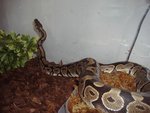Took this shot of my son's (Aaron) Long neck Tortoise...his name....drum roll...LUCKY.!!
IIRC.... a batch of them was brought to my wifes school to give away, somehow one got out of the box unnoticed and finished up in a box of books.
It should have been crushed when the box was moved and sometime later was found in the box of books unharmed..... my wife said I'll take 'him' and thats how he got his name...
He lives alone because he eventually catches and eats anything that is put in the tank!
IIRC.... a batch of them was brought to my wifes school to give away, somehow one got out of the box unnoticed and finished up in a box of books.
It should have been crushed when the box was moved and sometime later was found in the box of books unharmed..... my wife said I'll take 'him' and thats how he got his name...
He lives alone because he eventually catches and eats anything that is put in the tank!





